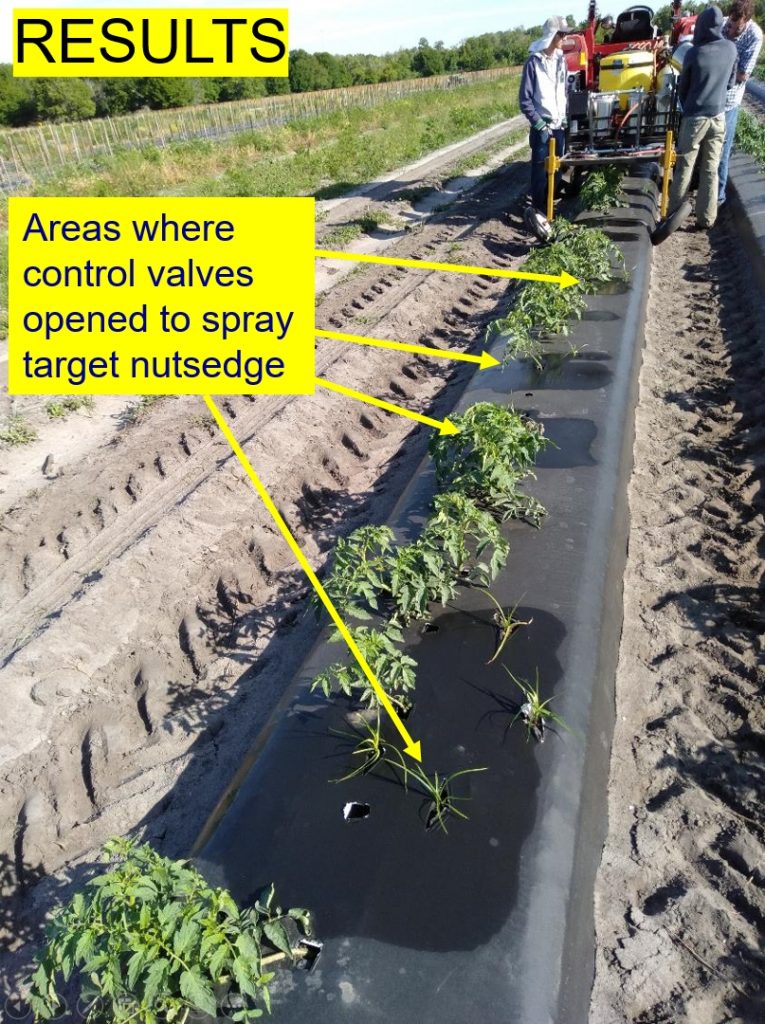By Arnold Schumann, Nathan Boyd, Shaun Sharpe and Jialin Yu
In the March 2019 issue of VSCNews, the University of Florida Institute of Food and Agricultural Sciences (UF/IFAS) smart sprayer technology using machine vision for Florida vegetable and strawberry crops (VSCNews.com/smart-sprayer-technology-for-better-weed-control) was introduced. Subsequently, a series of herbicide spray trials were conducted to prove that the smart sprayer performs well in various Florida plasticulture crops. This article presents the outcome of smart sprayer herbicide trials for nutsedge weed control in a tomato crop.

Yellow nutsedge (Cyperus esculentus) and purple nutsedge (Cyperus rotundus) are common perennial weeds of vegetable and strawberry plasticulture in Florida. Due to the ability of nutsedge weeds to puncture the plastic mulch and their strong competition with crop plants, post-emergence herbicides are often necessary to prevent yield losses. Herbicides may directly damage the vegetable and strawberry crops, increase the cost of production and potentially increase the risk of chemical residues on edible crops.
HOW IT WORKS
A precision sprayer with machine vision was developed to identify and spray only target weeds, thus reducing herbicide use as well as minimizing off-target crop contact with chemical residues. A digital camera and an embedded Linux computer with a color touchscreen (Figure 1) were mounted to a tractor-sprayer rig and programmed for capturing real-time digital images of the vegetable beds ahead of two sprayer nozzles.
A deep learning artificial neural network previously trained for identifying nutsedge weeds in the images was linked with GPS ground speed data in order to actuate two electric solenoid valves delivering herbicide mixture to the nozzles. The nozzles therefore delivered herbicide only when nutsedge weeds were detected. The prototype sprayer (Figure 2) was tested with Sandea (halosulfuron) herbicide in two tomato field trials located at the UF/IFAS Gulf Coast Research and Education Center.

Nutsedge control and tomato crop safety were assessed periodically for up to 56 days after treatment. The objectives of the field research were to demonstrate spray efficacy, crop safety and product savings when using precision spraying.
EQUAL CONTROL WITH LESS HERBICIDE
Average spray coverage for precision spraying was 65 to 77 percent of conventional full-spray coverage in the experiments, representing a reduction in Sandea herbicide use of 23 to 35 percent. Actual savings of herbicide achieved will vary, depending on the severity of nutsedge weed infestation in a given field.
Nutsedge populations were significantly reduced by both precision and conventional spraying, and nutsedge damage ratings for the two spray methods were statistically equal but higher than the unsprayed control. Therefore, despite the precision spray method using less herbicide than conventional broadcast spraying, the weed control was identical.
Tomato plant heights and fruit yields were not significantly affected by spraying methods in both experiments. The precision sprayer’s performance matched that of a conventional sprayer, while using only a fraction of the herbicide per acre and not damaging the tomato crop.
ADAPTABLE TECHNOLOGY
The precision sprayer can be easily adapted for spraying other weed species by training additional neural networks for each target weed. With the current prototype precision sprayer controller, a simple touchscreen interface can be used to select trained neural networks for spraying nutsedge or Carolina geranium on plastic-mulched beds, and broadleaf, grass and nutsedge weeds in row middles. More weed recognition neural networks will be developed and added as needed for different weed control situations.
Acknowledgements: Funding for this research was provided by a U.S. Department of Agriculture/Florida Department of Agriculture and Consumer Services Specialty Crop Block Grant and the Florida Strawberry Research and Education Foundation.









